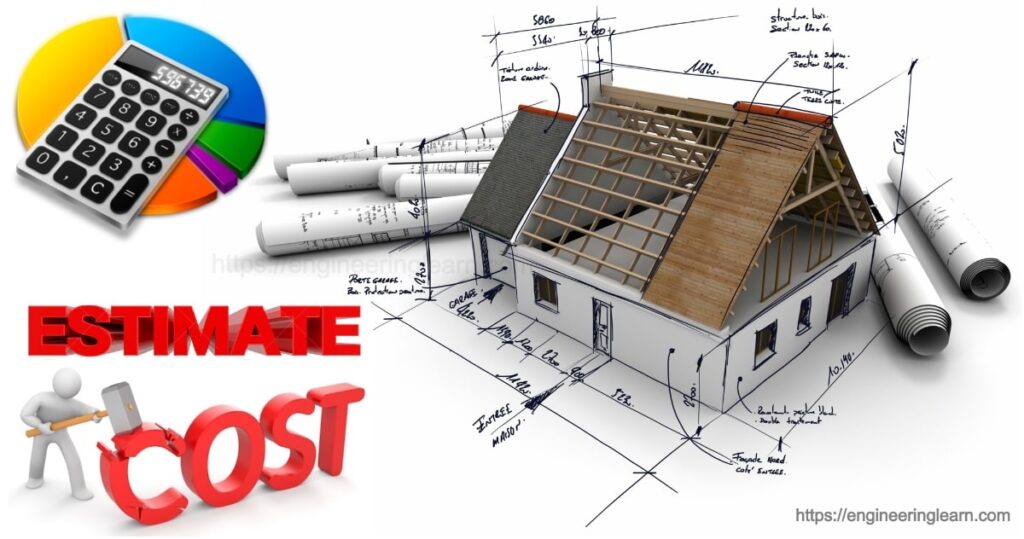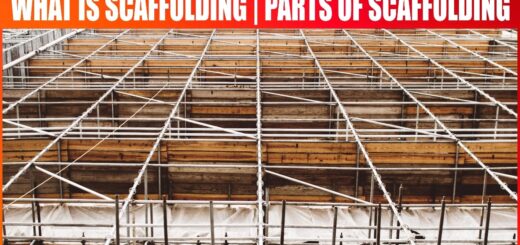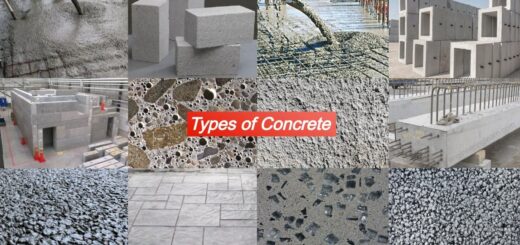Estimation and Costing

What is Estimated Cost?
Estimation and Costing in Civil Engineering :- All engineering works or construction works require the knowledge of probable cost of construction, beforehand, which is known as the estimated cost. If in any condition the estimated cost turns out to be greater than the funds/ money available, then attempts are made to reduce the cost. This can be done either by changing the specifications of the work or by reducing the work itself.
Accuracy in the estimation is of prime importance because if the estimate is exceeded it becomes very problematic for the engineers to account for and arrange the additional money. Inaccuracy in estimate can happen due to omission of items, improper rates, change in design, calculation mistakes etc. For making accurate estimates one should be proficient in finding out the specifications and dimensions from the plan, elevation and section of the drawing.
Process of Estimation in Construction
Estimate is basically the probable cost of a work. The estimate is calculated, before the commencement of the construction process, in order to derive or obtain the probable cost of any structure.
Estimation of any construction project is prepared by-
1) Calculating the quantities of material required for the construction
2) Calculating the total cost by multiplying the quantities with suitable rates.
This way one gets the total expenditure likely to be incurred in the construction of the work/ building. The estimate should cover – cost of materials, cost of labor, cost of transport, cost of scaffolding, cost of equipment’s and machines, cost of water, electricity, diesel, taxes, supervision cost, contractor cost etc.
What is Actual Cost?
After the completion of the work, the actual cost of the work can be assessed. On day to day basis an account of all the expenditure is maintained. These accounts are kept during the execution of the work and after the work is completed the final expenditure is calculated which gives the actual cost. However, it should be taken care that the estimated cost and the actual cost should not differ from each other.
What is Abstract or Estimated Cost?
The cost of each item of work is calculated from the quantities computed at the workable rates. This way the total cost is worked out in the prescribed form. It is to be noted that a percentage of 3 to 5 percent is added to the contingencies. This is done to allow for the small contingent expenditures, future expenditures which are unforeseen, changes in the design or fluctuations in the rates of materials, labors, machinery etc. in the market, which may occur during the execution of the work.
Also, a percentage of 1.5 to 2 percent is added to meet the expenditure requirements of work- charged establishment. The final total amount thus obtained is called the estimated cost of the work.
| Item Number | Quantity | Unit | Rate | Amount |
Main Items of Work in Estimation
1. Earthwork: ( Estimation and Costing )
The earthwork is calculated in cubic meters unit. There are two separate types of earthworks- first, the earthwork in excavation and second, the earthwork in filling. By calculating the exact width of foundation, the foundation trenches are dug out with vertical sides. Correct dimension of length, breadth and height of each foundation trench is taken and then the earthwork is calculated. Usually the filling of trenches after the construction is not taken care of hence it is neglected.
However in case trench filling is accounted, it is computed by deducting the masonry from excavation. In plinth level filling, the earthwork is calculated by taking out the dimensions (length x breadth) in between plinth wall, which are usually less than the internal dimensions of the room by two offsets of plinth wall i.e., 10 cm and height is taken by deducting the thickness of concrete in floor, usually 7.5 cm.
The earth which is excavated out is utilized in filling of the trenches and plinth filling. This is usually not paid for separately. This may be included as a separate item namely ‘Return fill and ram or backfill”. This is paid at lesser rates. If extra earth is required for filling, it may be brought from outside. The excess earth left after the completion of trench filling and plinth filling is utilized for the leveling and dressing. If not used the excess earth is removed from the site.
2. Concrete in foundation: ( Estimation and Costing )
The depth or thickness of the foundation concrete differs, however the length and breadth is usually the same. The concrete is usually calculated in the unit cubic meters. The thickness of the concrete usually varies in the range 20cm-45cm and on an average 30 cm is taken. Foundation concrete is mainly composed of lime concrete or weak cement concrete. Usually the proportions 1:4:8 or 1:5: 10 are taken of the cement concrete used in foundation.
3. Soling: ( Estimation and Costing )
The practice of applying one layer of dry brick or stone below the foundation concrete, when the soil is soft or bad, is known as soling. The soling layer is calculated in the unit square meter (length x breadth). The thickness is also specified.
4. Damp proof course: ( Estimation and Costing )
Generally the DPC of 2.5 cm(1”) thick rich cement concrete 1:1.5:3 or 2cm (0.75”) thick rich cement mortar 1:2 , mixed with standard waterproofing material, is provided at the plinth level to the complete width of the plinth wall and the quantities are computed in square meter, (length x breadth). Deductions are made in the sills of doors and verandah openings because there no DPC is applied.
5. Masonry: ( Estimation and Costing )
The computation of masonry is done in cubic meters (length x breadth x height). Masonry is dealt as two separate items- first – foundation and plinth masonry and second- masonry in superstructures. For a multi storey building the masonry is computed separately for each storey like the ground floor above plinth level, first floor, second floor etc. In masonry the walls are measured as solid in taking out the quantities. After that deductions are made for doors, windows etc (openings).
Different types or classes of masonry and masonry with different mortar are taken under separate items. Arch masonry work is taken as a separate item. In arch masonry, the splayed or rounded sides of walls are considered as rectangular and extreme dimensions are taken to find out the required quantities. The partition walls which are thin are calculated in square meters. In case of honey comb walls, it is dealt as a separate item and it is calculated in square meters. Suitable deductions are made for the holes also. The calculations done for the stone masonry is same as that made in brick masonry.
Data for Estimation (Estimation and Costing)
Estimating and Costing in Civil Engineering :- The primary objective of any estimation is to make one know beforehand the cost of the work/project. Actual cost of any work is only found after the completion of the work by checking the accounts of the expenditures. Hence, it becomes very important to prepare the estimate carefully and correctly so that there will not be a significant difference between the actual cost and the estimated cost. The estimator is required to be well experienced and fully acquainted with the methods of estimation.
For making an estimate for any construction work one needs the following data items, namely-
- Drawing (plans, section etc.)
- Specifications
- Rates
1. Drawings
For any construction project, drawings are very important. Detailed drawings, fully dimensional and drawn to scale are needed. Plan, sectional elevations are required in order to understand what is to be constructed. The plan, elevation and sectional elevations are drawn to a scale usually 1cm=1m(1”=8’). The detailed drawings are drawn to the scale 1cm=10cm to 1cm=29cm (1”=1 to 1”=2’).
2. Specifications
Specifications are of mainly two types, namely-
A) General specifications or brief specifications
B) Detailed specifications
A) General Specifications or Brief Specifications
These types of specifications give a general view regarding the nature, quality and class of work and materials to be used in the various tasks of the work. The general specifications help to form a general idea of the whole building or the structure. The general specifications are also helpful in making the detailed specifications.
B) Detailed Specifications
These types of specifications dives the detailed description of number of tasks in the work such as laying down the quantities and qualities of materials, measuring their proportions, method of preparation, workmanship and execution of the work. The very important property of the detailed estimation is to describe each and every item of the work completely, separately and in detail. This specification is very useful for the execution of different items of work
3. Rates
The rates of the following items must be known- rates per unit of various items of work, rates per unit of various materials to be used in the construction, rates of wages of different categories of labors like skilled, unskilled (mason, carpenter, mazdoor, kaarigar, electrician, plumber etc.) should be known to prepare the estimated of the construction project. Points such as the location of the work and the work site distance from the source of materials, cost of transportation etc should be known. Rates can be preferably taken from the P.W.D Schedule of Rate book or the rates may be worked out b the analysis of rate method.













